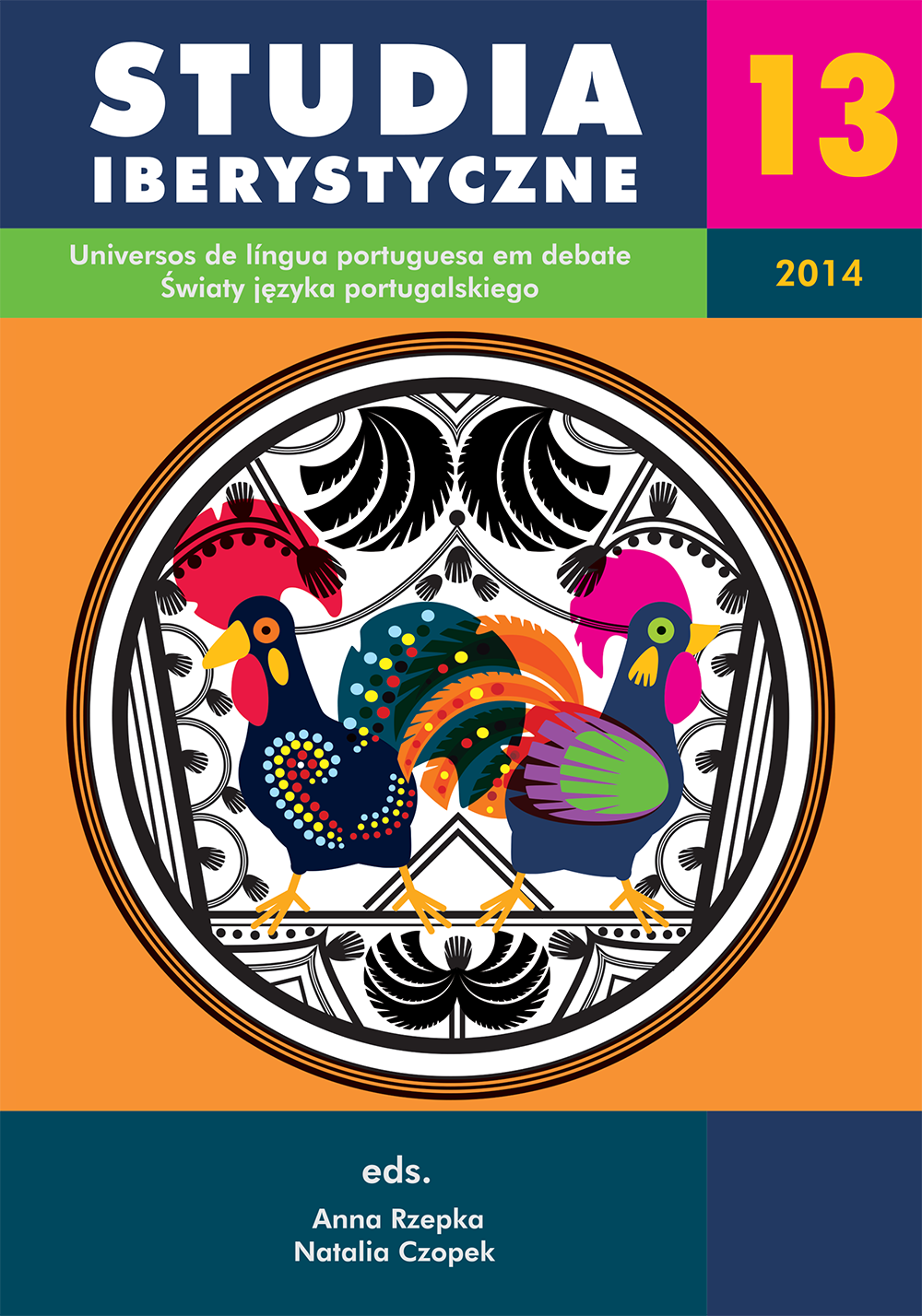De periferia a periferia: constantes e variações na história externa da tradução da literatura polaca em Portugal
DOI:
https://doi.org/10.12797/SI.13.2014.13.35Palabras clave:
external translation history, Portuguese language, Polish literature, indirect translation, literary translationResumen
FROM ONE PERIPHERY TO ANOTHER: CONSTANT AND VARIABLE FEATURES OF THE EXTERNAL HISTORY OF TRANSLATION OF POLISH LITERATURE IN PORTUGAL
This article aims at exploring (ir)regularities in the external history of Portuguese translations of Polish literature published in Portugal between 1855 and 2010. Firstly, the state of the art of research on the Portuguese translations of Polish literature is elucidated. Secondly, the results of analysis, guided by six main questions (what is translated, when, by whom, where, how and why?), are presented. Lastly, future research avenues are indicated.
Referencias
Almeida, L.F. (1967), “Portugal e Polónia”, em: Serrão, J. (ed.), Dicionário de história de Portugal, 3ºv., Livaria Figueirinhas, Porto, pp. 410‑415.
Danilewicz‑Zielińska, M. (2005), Polonica portugalskie, Więź, Warszawa.
Danilewicz‑Zielińska, M., Mucznik, L. (coord.) (1992), Imagem da Polónia, I.B.N.L., Lisboa.
Duarte, J.F. (2000), “The Politics of Non‑Translation: A Case Study in Anglo‑Portuguese Relations”, TTR, 13, 1, pp. 95‑112. DOI: https://doi.org/10.7202/037395ar
Even‑Zohar, I. (1990), “Polysystem Studies”, Poetics Today, 11, 1, pp. 53‑72. DOI: https://doi.org/10.2307/1772669
Frank, A.P. (1990), “Forty years of studying the American‑German translation transfer: A retrospect and some perspectives”, American Studies, 35, 1, pp. 7‑20.
GALP (Grupo de Amizade Luso–Polaca) (org.) (1938), Catálogo da exposição bibliográfica e iconográfica luso‑polaca, Tip. Liga dos Combatentes da Grande Guerra, Lisboa.
Kalewska, A. (2002), “Czesław Miłosz (1911‑2004): O poeta do «êxtase » e da «transitoriedade» na tradução luso‑brasileira”, Veredas, 5, pp. 7‑24.
Kalewska, A. (2011a), “A literatura polaca publicada em Portugal: Que futuro?”, Revista de Letras, II, 10, pp. 156‑185.
Lima, H.F.C. (1934), Relações entre Portugal e a Polónia, Minerva, Vila Nova de Gaia.
Medvedec, A. (2007), “Croatia and Portugal: Meeting points through literary translation”, em: Cieszyńska, B. (ed.), Iberian and Slavonic cultures: Contact and comparison, CompaRes, Lisboa, pp. 149‑172.
Milewska, E. (1984), A Polónia e Portugal: relações ao longo dos séculos, Interpress, Warszawa.
Milewska, E. (1991), Związki kulturowe i literackie polsko‑portugalskie w XVI‑XIX wieku, CESLA, Warszawa.
Miszalski, H. (2006), “Modificações nas traduções lusófonas de «Pornografia » de Witold Gombrowicz”, Tese de mestrado, Universytet Jagielloński, Kraków.
Pięta, H. (2009), “Sienkiewicz em português: para uma história da recepção de Quo Vadis no Portugal salazarista”, em: Seruya, T. [et al.] (ed.), Traduzir em Portugal durante o Estado Novo, UCE, Lisboa, pp. 325‑343.
Pięta, H. (2010a), “À procura de traduções da literatura polaca em Portugal: algumas questões sobre o uso de fontes bibliográficas na história da tradução”, Itinerarios, 11, pp. 121‑139.
Pięta, H. (2010b), “Portuguese translations of Polish literature published in book form: some methodological issues”, em: Azadibougar, O. (ed.), Translation Effects, CETRA, Leuven.
Pięta, H. (2010c), “Traduções do polaco publicadas em Portugal (1855‑2009): alguns traços mais salientes”, Acta Philologica, 37, pp. 271‑277.
Pięta, H. (2011), “Autores polacos em tradução portuguesa (1855‑2010): um levantamento preliminar”, Cadernos de Tradução, 28, 2, pp. 97‑120. DOI: https://doi.org/10.5007/2175-7968.2011v2n28p97
Pięta, H. (2012a), “(Non)translation of Polish literature during the Portuguese First Republic”, IberoSlavica, 2, pp. 99‑111.
Pięta, H. (2012b), “Patterns in (in)directness: an exploratory case study in the external history of Portuguese translations of Polish literature (1855‑2010)”, Target, 24, 2, pp. 310‑337. DOI: https://doi.org/10.1075/target.24.2.05pie
Pięta, H. (2013), “Patterns in the external history of Portuguese collections with translations of Polish literature (1855‑2009): An exploratory case study”, em: Seruya, T. [et al.] (ed.), Translation in Anthologies and Collections (19th and 20th Centuries), pp. 153‑170. DOI: https://doi.org/10.1075/btl.107.13pie
Pięta, H. (aceite), “A friend and a foe: On the role of literary translation in the construction of the conflicting images of communist Poland in para‑fascist Portugal (1945‑1974)”, em: Doorslaer, L. van [et al.] (ed.), Intersecting Translation and Image Studies, John Benjamins, Amsterdam.
Siewierski, H. (2000), Histórica da literatura polonesa, Universidade de Brasília, Brasília.
Toury, G. (1995), Descriptive Translation Studies and Beyond, John Benjamins Publishing, Amsterdam. DOI: https://doi.org/10.1075/btl.4
Ziejka, F. (2008), Moja Portugalia, Universitas, Kraków.
Zurbach, C. (2008), “Censorship(s) and contradictions: the «draw» (1971/72) of Witkiewicz’s play The Mother”, em: Seruya T., Moniz, M. L. (ed.), Translation and censorship in different times and landscapes, Cambridge Scholars, Newcastle, pp. 74‑83.
Descargas
Publicado
Número
Sección
Licencia
Derechos de autor 2014 Hanna Pięta

Esta obra está bajo una licencia internacional Creative Commons Atribución-NoComercial-SinDerivadas 4.0.






